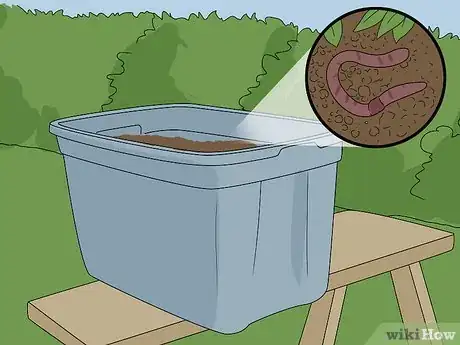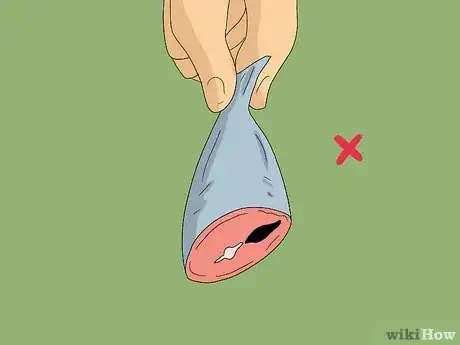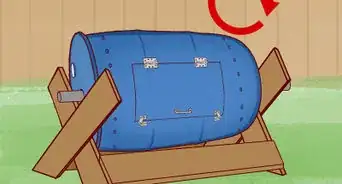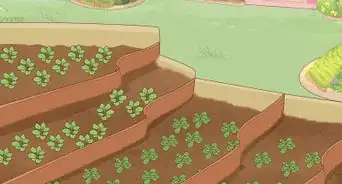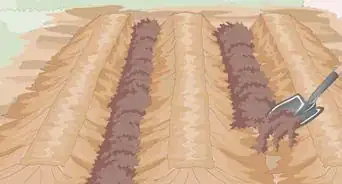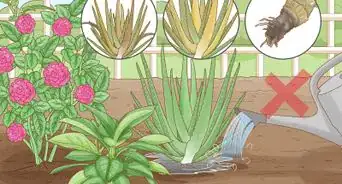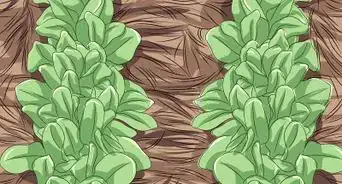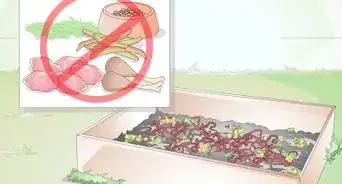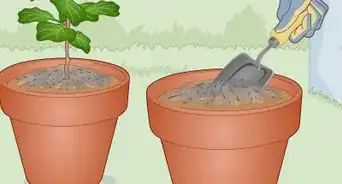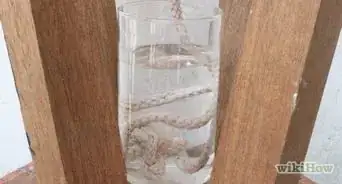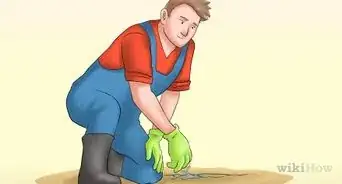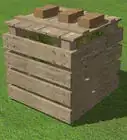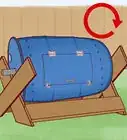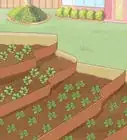This article was co-authored by Maggie Moran. Maggie Moran is a Professional Gardener in Pennsylvania.
wikiHow marks an article as reader-approved once it receives enough positive feedback. This article received 25 testimonials and 93% of readers who voted found it helpful, earning it our reader-approved status.
This article has been viewed 1,396,450 times.
Vermicomposting, or worm composting, allows you to compost your food waste rapidly, while producing high quality compost soil and fertilizing liquid. Best of all, it's self-contained and nearly odorless.
Steps
Making a Home for Your Worms
-
1Obtain a worm bin. The worm bin is basically the home for the worms, and the place where they digest the organic material you will give them. Worm bins can be purchased from many online vendors, or from your local gardening or farm supply store.
-
2If you don't want to buy a worm bin, you can also build one on your own. Use rubber storage totes, galvanized tubs, wood, or plastic.[1]
- Material: Rubber is cheap, easy to use and durable. Galvanized tubs are somewhat costly but will last forever. Wood will eventually be eaten, and plastic cracks easily, but either will do in a pinch. Some people prefer wooden compost worm bins because they may breathe better and absorb excess moisture, which can be hazardous to the worms. Just don't use chemically-treated wood, which may be dangerous to worms or leach harmful chemicals into your compost. 5 gallon (18.9 L) plastic buckets now for sale by most hardware stores can be used - especially if you live in an apartment. Clean the 5 gallon (18.9 L) buckets thoroughly with soap and let them sit for a day or so filled with clean water before using as a worm bin.
- Ventilation: Your bin should be well-ventilated, with several 1/8 inch (3mm) holes 4 inches (100mm) from the bottom (otherwise the worms will stay at the bottom of the bin and you may drown your worms). For example, you can build a worm bin out of a large plastic tub with several dozen small holes drilled out on the bottom and sides. Untreated wooden bins are naturally ventilated because of structure of wood.
- Size: The larger you make the container, the more worms it can sustain. Estimate 1 pound (0.45kg) of worms for every square foot of surface area. The maximum productive depth for your bin is 24 inches (61cm) deep because composting worms will not go further down than that.
- Cover: The bin should have a cover to prevent light from getting in and to prevent the compost from drying out. Choose or make a lid that can be removed if your compost is too wet. Use a canvas tarp, doubled over and bungee-corded on, or kept in place with wood. Burlap sacks also work well, and can be watered directly.
Advertisement -
3Use four old car tires for a makeshift home. To make a four-tire wormery, create a base from old bricks or flagstones (must be flat and with as few cracks as possible).
- Place a layer of heavy newspaper on top of the bricks. Stuff four old tires with newspapers.
- Pile the tires on top of each other, with the first tire on the Sunday newspaper. Put some scrunched up paper or cardboard in the bottom to soak up any excess liquid.
- Fill the entire wormery with organic material (semi-composted is best). Add the composting worms (tiger or brandling species are best).
- Use a piece of board weighed down with bricks as a lid. The lid must be big enough to stop rain getting in.
- Harvest a tire's worth of fertilizer roughly every 8 weeks (during warm months).
-
4Place the worm bin in a cool area to protect it from excessive heat. If you're keeping your worm bin outside, consider placing it in the shade, under a tree, in the garage or shed, or along the side of the house.
- Try keeping the outdoor temperature in the bin between 30 and 70 degrees Fahrenheit, along with at least 4 inches of moist bedding in the bin. This should be an ideal home for your compost-zapping worms.
Building Your Ecosystem
-
1Prepare the bedding for your worms. The bedding is the natural habitat of the worm that you're trying to replicate in your compost bin. Fill your bin with thin strips of unbleached corrugated cardboard or shredded newspaper, straw, dry grass, or some similar material. This provides a source of fiber to the worms and keeps the bin well-ventilated. Sprinkle a handful of dirt on top, and thoroughly moisten. Allow the water to soak in for at least a day before adding worms.[2]
- Over time, the bedding will be turned into nutrient-rich compost material by the worms. When you harvest the composted soil, you'll have to introduce new bedding into the worm bin again.
- Canadian peat moss, sawdust, (rinsed) horse manure, and coconut pith fiber are also great for composting.
- Avoid putting pine, redwood, bay or eucalyptus leaves into your bedding. Most brown leaves are acceptable in vermicompost, but eucalyptus leaves in particular act as an insecticide and will kill off your worms.
-
2Choose which worms you want. There are several varieties of worms that that are bred and sold commercially for vermicomposting; just digging up earthworms from your backyard is not recommended.[3] The Internet or local gardening club is your best bet for finding a worm vendor near you. A pound of worms is all that is recommended.
- The worms most often used, Eisenia fetida (Red Wigglers), are about 4 inches long, mainly red along the body with a yellow tail. These worms have a healthy appetite and reproduce quickly. They are capable of eating more than half their own weight in food every day.
- Another variety to consider are Eisenia hortensis, known as "European night crawlers." They do not reproduce quite as fast as the red wigglers, but grow to be larger, eat coarser paper and cardboard better, and seem to be heartier. They are also better fishing worms when they do reach full size.
- However, as with any non-native species, it is important not to allow European night crawlers to reach the wild. Their voracious appetites and reproductive rates (especially among the red wigglers) have been known to upset the delicate balance of the hardwood forests by consuming the leaf litter too quickly. This event leaves too little leaf litter to slowly incubate the hard shelled nuts and leads to excessive erosion as well as negatively affecting the pH of the soil. So, do your best to keep them confined![4] of worms to start. Horticulturalist Maggie Moran advises, “It is ideal to start with between 1 and 3 pounds (0.45 and 1.36 kg) of worms, depending on the size of the bin. On average it takes 5–7 pounds (2.3–3.2 kg) of food each week to sustain a worm bin.”|}}
Maintaining and Harvesting Your Compost
-
1Feed your worms digestible amounts regularly. The bedding of your compost bin is a great start, but the worms need a steady diet of food scraps in order to stay healthy and produce compost. Feed your worms at least once a week in the beginning, but only a small small amount. As the worms reproduce and grow in numbers, try to feed them at least a quart of food scraps per square foot of surface area each week.[5]
- Worms eat fruit and vegetable scraps; bread and other grains; tea leaves; coffee grounds; and egg shells. Worms eat basically what humans eat, except they are much less picky!
- If you can process your scraps before you introduce them into the compost bin, you'll find that your worms will eat them quicker. Worms go through smaller-sized food more quickly than they can larger-sized or whole food. In this respect, they are also like humans.
- Mix the scraps into the bedding when you feed the worms. This will cut down on fruit flies and will give the worms more opportunities to eat. Don't just leave the scraps on top of the compost heap.
-
2Maintain your bin. Keeping your bin elevated off the ground, using bricks, cinder blocks, or whatever is convenient will help speed composting and keep your worms happy. Worms are capable of escaping almost anything, but if you keep your worms fed and properly damp, they should not try to escape. A light in the same area will ensure your worms stay put.
- Sprinkle the surface with water every other day. You want your bedding to have the dampness of a wrung-out sponge.
- Add more cardboard, shredded newspaper, hay, or other fibrous material once a month, or as needed. Your worms will reduce everything in your bin quickly. You will start with a full bin of compost or paper/cardboard, and soon it will be half full. This is the time to add fibrous material.
-
3Pay attention to some composting "dont's". Composting bins are not difficult to maintain, but they do need to be looked after. Here are some things that you shouldn't do if you want a healthy, hearty ecosystem.[6]
- Don't feed your worms too much. If your compost bin starts to smell, it could be because you are feeding your worms more than they can process. When this happens, the bedding can also heat up, killing off the worms.
- Don't feed your worms any combination of the following. These foods are difficult for the worms to digest:
- Excessive citrus — no more than 1/5 of the total worm food
- Meats or fish
- Fats or excessively oily scraps
- Dairy products (eggshells are fine)
- Cat or dog feces
- Twigs and branches
-
4Harvest the compost once it's ready. After 3-6 months, you should have a fair amount of worm compost stored up in your bin. Now it's time to harvest. Keep in mind that you might not be able to save every worm when harvesting the compost. That's okay; by and large, your worms have multiplied, and there should be plenty to continue composting.
- Put on rubber gloves, and move any large un-composted vegetable matter to one side. Then, with your gloved hands, gently scoop a section of worms and compost mixture onto a brightly lit piece of newspaper or plastic wrap. Scrape off the compost in layers. Wait a while giving the worms time to burrow into the center of the mound. Eventually you will end up with a pile of compost next to a pile of worms. After harvesting, you should replace the bedding and then return the worms to the bin, do whatever you want with the compost, and repeat.
- If you prefer a hands-off technique, simply push the contents of the bin all to one side and add fresh food, water, dirt, and bedding to the empty space. The worms will slowly migrate over on their own. This requires much more patience, of course. It could take up to a few months for the worms to fully migrate to the scraps-side of the compost bin.
Expert Q&A
Did you know you can get expert answers for this article?
Unlock expert answers by supporting wikiHow
-
QuestionHow long does it take for a worm to reproduce?
 Maggie MoranMaggie Moran is a Professional Gardener in Pennsylvania.
Maggie MoranMaggie Moran is a Professional Gardener in Pennsylvania.
Home & Garden Specialist
-
QuestionHow many worms do you need to start a worm bin?
 Maggie MoranMaggie Moran is a Professional Gardener in Pennsylvania.
Maggie MoranMaggie Moran is a Professional Gardener in Pennsylvania.
Home & Garden Specialist
-
QuestionHow much money can you make selling worms?
 Maggie MoranMaggie Moran is a Professional Gardener in Pennsylvania.
Maggie MoranMaggie Moran is a Professional Gardener in Pennsylvania.
Home & Garden Specialist
Warnings
- Large amounts of green feeds (grass, alfalfa, etc.) heat up quickly and should be added lightly.⧼thumbs_response⧽
- Fresh (un-composted) cow manure contains harmful pathogens and should not be used. It will also heat the bin to deadly levels and kill your worms.⧼thumbs_response⧽
- Go easy on the citrus rinds. You can add them, but remember that they're acidic. If possible, add only a little at a time with plenty of other matter.⧼thumbs_response⧽
- Powdered limestone will create carbon dioxide in your bins and suffocate your worms if the bins are not well ventilated. Use sparingly only if absolutely necessary and stir your bin every few days following adding.⧼thumbs_response⧽
- If cool temperatures are an issue in your area, move outdoor bins into a garage or shed during winter. If bringing your worm bin indoors during the winter is not possible, add a small heating pad as follows: push the matter away from one side, place the pad up against that side, then backfill onto the pad. Run the wire out to an extension, plug it in and leave the pad set on low - or medium in particularly cold weather. This will prevent freezing in winter.⧼thumbs_response⧽
- Don't allow your worm bin to heat up past 90 degrees.[7] You will cook your worms -- something no one should smell.⧼thumbs_response⧽
References
- ↑ https://www.epa.gov/recycle/how-create-and-maintain-indoor-worm-composting-bin
- ↑ http://compost.css.cornell.edu/worms/steps.html
- ↑ http://www.homecompostingmadeeasy.com/wormcomposting.html
- ↑ https://www.dnr.state.mn.us/invasives/terrestrialanimals/earthworms/index.html
- ↑ http://compost.css.cornell.edu/worms/steps.html
- ↑ http://www.homecompostingmadeeasy.com/wormcomposting.html
- ↑ https://aggie-horticulture.tamu.edu/archives/parsons/publications/worm/worm.html
About This Article
To make your own worm compost system, build or purchase a worm bin and fill it with organic, semi-composted material and bedding for the worms. Place the worm bin in a cool, shady spot and add the composting worms, then add in fruit and vegetable peels, bread crusts, coffee grounds, and other food scraps at least once a week. Sprinkle the surface of the compost bin with water every other day. For advice from our horticulture reviewer on what you shouldn’t put into your bin, like meat or large amounts of citrus, keep reading!
